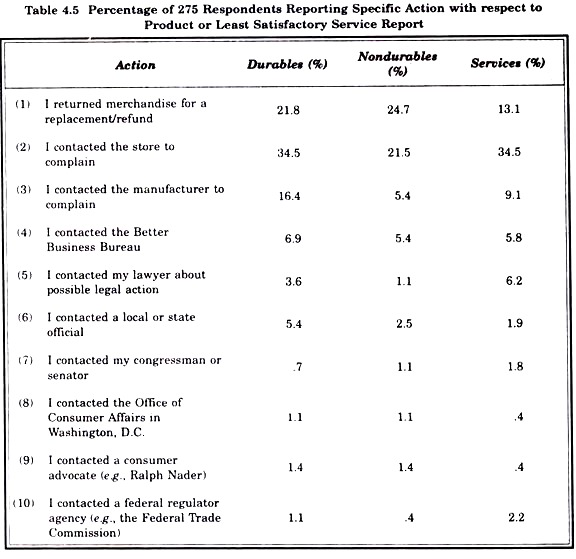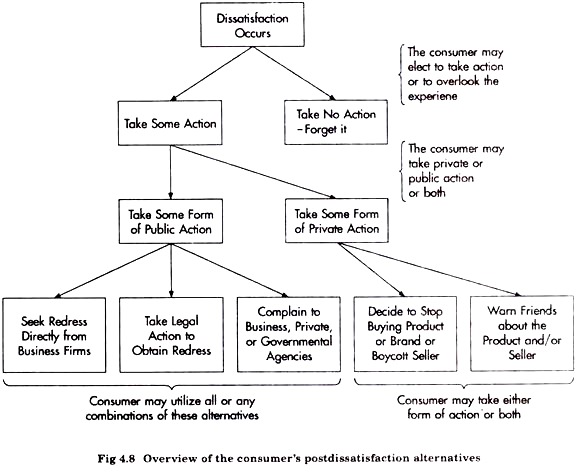This article throws light upon the two main alternatives actions taken by dissatisfied consumers. The alternative actions are: 1. Private Alternatives 2. Public Alternatives.
Action # 1. Private Alternatives:
The dissatisfied consumer may decide to resolve his dissatisfaction in a private or personal way. The most private way, of course, is to do nothing at all and say nothing to anyone. Thus the dissatisfaction is felt but is then suppressed without having any effect on the individual’s behaviour.
In Day and Landon (1976), the Respondents indicated which action(s) from a possible list of 13 they had taken with respect to the one particular item in each of the three broad categories of products and services they had experienced the most dissatisfaction with.
The response, “I didn’t do any thing at all,” was checked by 26.5% of the sample with respect to nondurable products, by 22.9% for durable products, and by 16.0% for services and intangible products.
In a recent national telephone study of the “principal grocery shopper” in 1,000 households, 540 respondents reported having encountered one or more defective products among items normally purchased at grocery stores. Those respondents reported that in 45% of the 1,307 total instances involving defective products the experience has no effect at all on their behaviour.
The nondurables section of the study by the authors covered a broader range of product types, including some more complex and expensive items than the grocery store merchandise covered by the Nelson study, so it is not surprising that the percentage who took no action is considerably lower.
Another telephone study dealing with complaints recalled by respondents with respect to any type of product or service found that 25% of the 1,215 respondents in a national probability sample indicated they had recently experienced extreme dissatisfaction but had done nothing.
While the results of any one of these three studies should be generalized with considerable caution, if at all, their common finding that a substantial portion of dissatisfied consumers take no action whatever when they have an unsatisfactory experience can hardly be disregarded.
Consumers who are unwilling to ignore their dissatisfactions but wish to resolve them in a private or personal way can modify their future purchasing behaviour and/or urge their family and friends to do so.
The national study by the A.C. Nielson Company reported that when grocery purchasers found defects in products they stopped buying that type of product in 19% of the cases and switched to another brand in 25% of the cases.
The authors found that 54% of the respondents indicated they would never again purchase the particular nondurable item that they had designated as the most unsatisfactory. More than 45% of the respondents in this study reported that they had told their friends about their unsatisfactory experiences and urged them to boycott these products or services.
These results suggest that knowledge of the private actions of consumers may be more significant to marketers than the visible actions of those who seek redress or complain about their experiences.
Action # 2. Public Alternatives:
When the dissatisfied consumer decides to do something more than change his or her own purchase behaviour and/or urging his family and friends to change theirs, three major courses of action are open to him:
1. Make an effort to obtain redress by contacting the seller and/or manufacturer and asking for the appropriate corrective action.
Depending on the nature of the product or service and the particular circumstances, this may entail an adjustment of the price paid, a full refund of the purchase price, replacement of the item, free repairs and replacement of defective parts, or the payment of damages for injuries or losses caused by substandard performance.
2. Take legal action to obtain the appropriate redress either immediately upon the occurrence of the dissatisfaction or after the failure of direct efforts to obtain redress from the seller or manufacturer.
3. Register a complaint as an alternative to attempting to obtain redress, as a means of seeking assistance in obtaining reparations from the seller or manufacturer, or to record a protest after all efforts to obtain compensation have failed. Past studies of complaining behaviour suggest that efforts to obtain redress or to complain about unsatisfactory experiences are most often directed to the seller or the manufacturer.
While the available data are far from definitive, most complaints made to better business bureaus, consumer organizations, and governmental agencies result either from unsuccessful efforts to obtain redress or a lack of knowledge about how to do it.
The data in Table 4.5 from the previously cited study by the authors describe this process. Substantial percentages of the respondents reported they had returned unsatisfactory items to the seller for replacement or refund or had complained to either the store or the manufacturer.
Smaller percentages indicated they had contacted agencies or individuals outside of the channel of distribution. These percentages were very small in the case of consumer nondurables, reflecting the refund or replacement policies followed by a majority of retail stores for items of this type.
Figure 4.8 depicts the major behavioral options available to the dissatisfied consumer. The extent to which the various options are exercised varies with the nature of the product and how important it is to the consumer.
For small ticket nondurable items, it is likely that unsatisfactory experiences are simply ignored in roughly one-third of the cases and that only “personal action” is taken in perhaps half of the cases. Most of the remaining cases involving nondurables are resolved by contacting the store, and complaints occur in 5% or less of the cases.
With the more expensive nondurables, the more complex and expensive durable products, and with services and intangible products, the chances that the consumer will do nothing at all or take only private action are lower but still appear to be substantial.
Hopefully, adequate data banks will be developed within the next few years so that patterns of complaining behaviour for particular classes of products may identified with greater precision.

